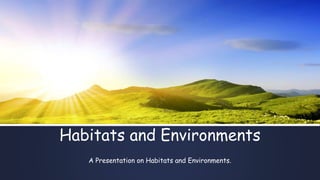
Habitats and environments by Asad Ali
- 1. Habitats and Environments A Presentation on Habitats and Environments.
- 2. What is a Habitat? A habitat is an ecological or environmental area that is inhabited by a particular species of animal, plant, or other type of organism. A place where a living thing lives is its habitat. It is a place where it can find food, shelter, protection and mates for reproduction. It is the natural environment in which an organism lives, or the physical environment that surrounds a species population. A habitat is made up of physical factors such as soil, moisture, range of temperature, and availability of light as well as bioticfactors such as the availability of food and the presence of predators. A habitat is not necessarily a geographic area—for a parasitic organism it is the body of its host, part of the host's body such as the digestive tract, or a cell within the host's body.
- 3. What is an Environment? The environment is the biotic and abiotic surrounding of an organism or population, and consequently includes the factors that have an influence in their survival, development and evolution. The environment can vary in scale from microscopic to global in extent. It can also be subdivided according to its attributes. Examples include the marine environment, the atmospheric environment and the terrestrial environment. The number of environments is countless, given that each living organism has its own environment.
- 4. What is an Ecosystem? An ecosystem is a community of living organisms called producers, consumers, and decomposers. These biotic and abiotic components are regarded as linked together through nutrient cycles and energy flows.The relationship between the abiotic components and the biotic components of the ecosystem is termed 'holocoenosis'. As ecosystems are defined by the network of interactions among organisms, and between organisms and their environment, they can be of any size but usually encompass specific, limited spaces (although some scientists say that the entire planet is an ecosystem, which is probably true).
- 5. What are Food Chain and Food Web? Food Chains A food chain is a linear network of links in a food web starting from producer organisms (such as grass or trees which use radiation from the sun to make their food) and ending at apex predator species (like grizzly bears or killer whales), detritivores (like earthworms or woodlice), or decomposer species (such as fungi or bacteria). A food chain also shows how the organisms are related with each other by the food they eat. Each level of a food chain represents a different trophic level. A food chain differs from a food web, because the complex network of different animals' feeding relations are aggregated and the chain only follows a direct, linear pathway of one animal at a time. A common metric used to quantify food web trophic structure is food chain length. In its simplest form, the length of a chain is the number of links between a trophic consumer and the base of the web and the mean chain length of an entire web is the arithmetic average of the lengths of all chains in a food web. Food Webs A food web (or food cycle) is the natural interconnection of food chains and generally a graphical representation (usually an image) of what-eats-what in an ecological community. Another name for food web is a consumer-resource system. Ecologists can broadly lump all life forms into one of two categories called trophic levels: 1) the autotrophs, and 2) the heterotrophs. To maintain their bodies, grow, develop, and to reproduce, autotrophs produce organic matter from inorganic substances, including both minerals and gases such as carbon dioxide. These chemical reactions require energy, which mainly comes from the sun and largely by photosynthesis, although a very small amount comes from hydrothermal vents and hot springs. A gradient exists between trophic levels running from complete autotrophs that obtain their sole source of carbon from the atmosphere, to mixotrophs (such as carnivorous plants) that are autotrophic organisms that partially obtain organic matter from sources other than the atmosphere, and complete heterotrophs that must feed to obtain organic matter.
- 6. Carnivores, Herbivores and Omnivores A carnivore /ˈkɑːrnɪvɔər/ meaning 'meat eater' (Latin, caro meaning 'meat' or 'flesh' and vorare meaning 'to devour') is an organism that derives its energy and nutrient requirements from a diet consisting mainly or exclusively of animal tissue, whether through predation or scavenging. A herbivore is an animal anatomically and physiologically adapted to eating plant material, for example foliage, for the main component of its diet. As a result of their plant diet, herbivorous animals typically have mouthparts adapted to rasping or grinding. Horses and other herbivores have wide flat teeth that are adapted to grinding grass, tree bark, and other tough plant material. An omnivore /ˈɒmnivɔər/ is an animal whose species normally derives its energy and nutrients from a diet consisting of a variety of food sources that may include plants, animals, algae, fungi, and bacteria. Omnivores are often opportunistic, general feeders that lack carnivore or herbivore specializations for acquiring or processing food, but which nevertheless consume both animals and plants
- 7. Made By: Asad Ali, M.Shahzaib and Fahd Khan.
